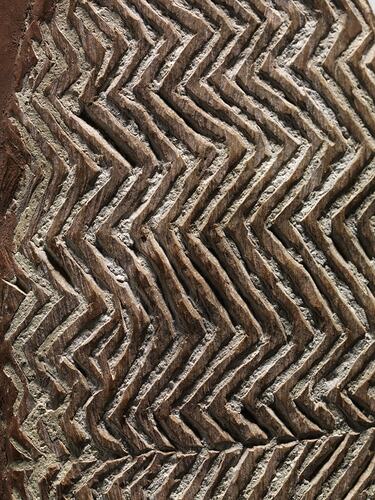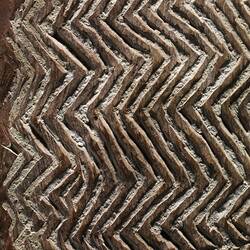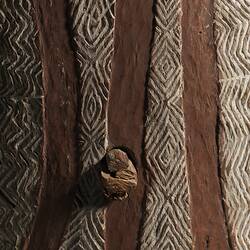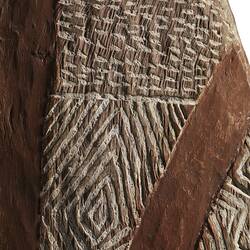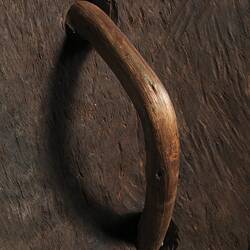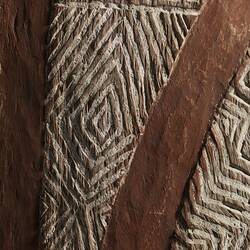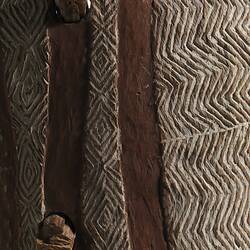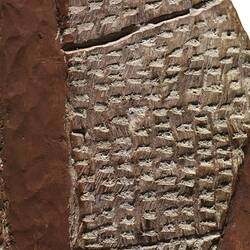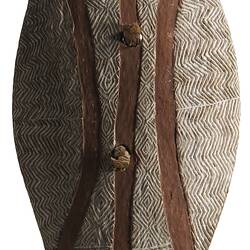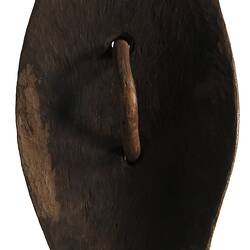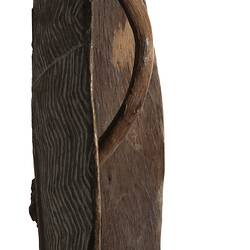Summary
The giyami (shield) is lighter than the parrying shield and was used to ward off spears in a battle, never in one-on-one combat. A skilful warrior would adeptly use the giyami to protect all parts of his body, making it impossible for the spear of his enemy to wound him.
The giyami was made from green bark cut from a eucalyptus tree. It is slightly convex in shape and has a small handle attached. The craftsman would shape the piece of bark in the desired form and then place it on hot ashes on a mound of earth, before covering it with heavy stones and earth. By the time the ashes were cold, the bark would have taken the curve of the mound. The handle is formed from a separate piece of green wood forced into the two holes cut into the shield; once dried, it is very difficult to remove.
Ornamenting shields is undertaken with great skill and care, and complex incised designs feature on the wooden implements from south-eastern Australia. The tool used to engrave this pattern was usually made from the lower jaw of a possum, or else a fine stone mounted onto a wooden handle. The front of the giyami is coated in red ochre, and the incised grooves filled with white pipeclay.
Local Name
Giyami
Physical Description
The thin carved wooden shield is slightly convex, leaf shaped and has the top and bottom ends extended out to a square end slightly wider than the junction with the main body of the shield. The handle consists of piece of cane. On the top surface the decoration consists of three lengthwise flat stripes carved into the surface. The centre one goes the full length of the shield whereas the other two are curved, being close to the centre line in the middle of the shield but further away where they meet the edge of the shield. All three are painted red. At either end the space between the red stripe and the edge of the shield is covered in small peck marks which have been filled with white clay. The spaces to either side between the curved lines and the edge are filled with parallel narrow chevron lines filled with white clay. The spaces between the centre line and the two curved lines is filled with concentric diamond patterns also filled with white clay. The underside of the shield is plain.
Significance
This giyami (shield) was made by the Wemba Wemba peoples. The Wemba Wemba Nation straddles both sides of the Murray River and includes the large townships of Deniliquin, Moulamein and Swan Hill. Wemba Wemba country also includes the major tributaries of the Edward River and Wakool River.
On Monday February 5, 2016 Swan Hill Primary School Wemba Wemba Class students, together with the Victorian Aboriginal Corporation for Languages and the Victorian Aboriginal Education Association, launched a Wemba Wemba language resource in the form of an interactive digital app. This resource contains images and wordlist categories in the Wemba Wemba language which allows the Wemba Wemba community to learn the language and connect further with Wemba Wemba Country. The application features Wemba Wemba language speakers Stephanie Charles and Fay Stewart. This resource is an excellent example of the use of new technologies to assist in language and cultural renewals being undertaken by many Aboriginal communities. Of the language revival currently underway in the Wemba Wemba community Stephanie Charles says;
'A lot of the kids out here today, they wouldn't have heard their grandmother or grandfather speak [in language] I think it's a way of connecting them to the land, to their culture and kids will sort of grasp that at a very young age. And I'm learning as I go with the kids, so it's something that we're learning along the way between one another.' Aunty Stephanie Charles, 2016.
Reference: http://www.abc.net.au/news/2016-02-24/swan-hill-students-combining-technology-and-culture-to-give-new/7196798
http://www.vaclang.org.au/languages/wembawemba.html
More Information
-
Object/Medium
Shield
-
Maker
-
Locality
-
Date Produced
-
Overall Dimensions
240 mm (Width), 55 mm (Depth), 900 mm (Height)
-
Classification
-
Date Made
-
Maker
-
Clan/Language Group
-
Place Made
-
Indigenous Region
-
Keywords
-
References
[Catalogue] Rowlison, Eric, et al. 1981. Aboriginal Australia.
-
Type of item
-
Discipline
-
Category
-
Collecting Areas
